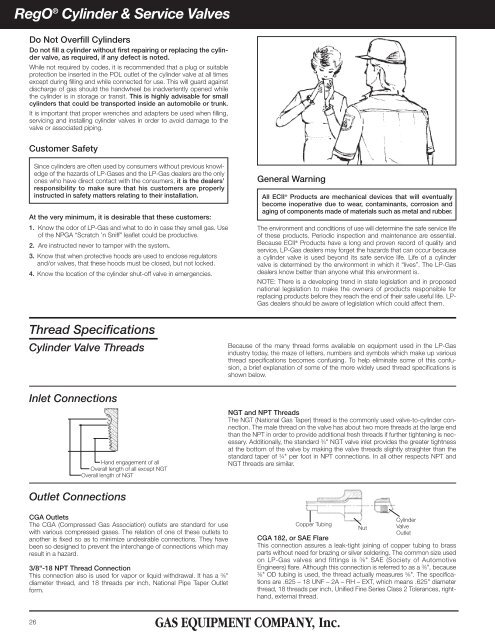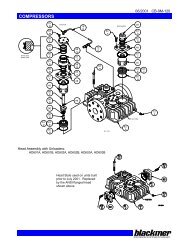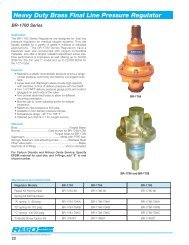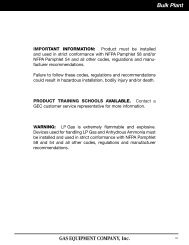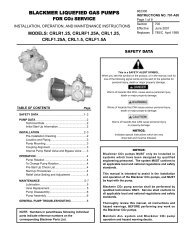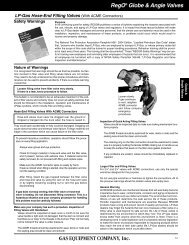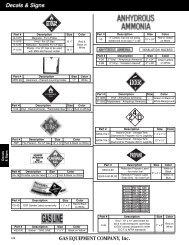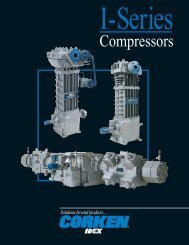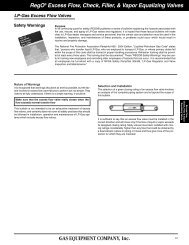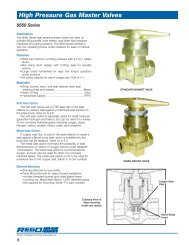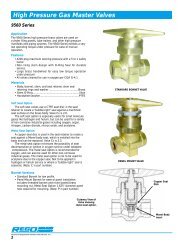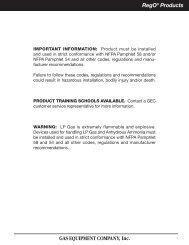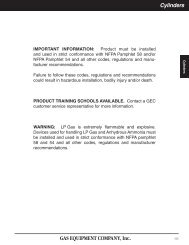RegO® Cylinder & Service Valves - Gas Equipment Company, Inc.
RegO® Cylinder & Service Valves - Gas Equipment Company, Inc.
RegO® Cylinder & Service Valves - Gas Equipment Company, Inc.
Create successful ePaper yourself
Turn your PDF publications into a flip-book with our unique Google optimized e-Paper software.
RegO ® <strong>Cylinder</strong> & <strong>Service</strong> <strong>Valves</strong><br />
Do Not Overfill <strong>Cylinder</strong>s<br />
Do not fill a cylinder without first repairing or replacing the cylinder<br />
valve, as required, if any defect is noted.<br />
While not required by codes, it is recommended that a plug or suitable<br />
protection be inserted in the POL outlet of the cylinder valve at all times<br />
except during filling and while connected for use. This will guard against<br />
discharge of gas should the handwheel be inadvertently opened while<br />
the cylinder is in storage or transit. This is highly advisable for small<br />
cylinders that could be transported inside an automobile or trunk.<br />
It is important that proper wrenches and adapters be used when filling,<br />
servicing and installing cylinder valves in order to avoid damage to the<br />
valve or associated piping.<br />
Customer Safety<br />
Since cylinders are often used by consumers without previous knowledge<br />
of the hazards of LP-<strong>Gas</strong>es and the LP-<strong>Gas</strong> dealers are the only<br />
ones who have direct contact with the consumers, it is the dealers’<br />
responsibility to make sure that his customers are properly<br />
instructed in safety matters relating to their installation.<br />
At the very minimum, it is desirable that these customers:<br />
1. Know the odor of LP-<strong>Gas</strong> and what to do in case they smell gas. Use<br />
of the NPGA “Scratch ’n Sniff” leaflet could be productive.<br />
2. Are instructed never to tamper with the system.<br />
3. Know that when protective hoods are used to enclose regulators<br />
and/or valves, that these hoods must be closed, but not locked.<br />
4. Know the location of the cylinder shut-off valve in emergencies.<br />
General Warning<br />
All ECII ® Products are mechanical devices that will eventually<br />
become inoperative due to wear, contaminants, corrosion and<br />
aging of components made of materials such as metal and rubber.<br />
The environment and conditions of use will determine the safe service life<br />
of these products. Periodic inspection and maintenance are essential.<br />
Because ECII ® Products have a long and proven record of quality and<br />
service, LP-<strong>Gas</strong> dealers may forget the hazards that can occur because<br />
a cylinder valve is used beyond its safe service life. Life of a cylinder<br />
valve is determined by the environment in which it “lives”. The LP-<strong>Gas</strong><br />
dealers know better than anyone what this environment is.<br />
NOTE: There is a developing trend in state legislation and in proposed<br />
national legislation to make the owners of products responsible for<br />
replacing products before they reach the end of their safe useful life. LP-<br />
<strong>Gas</strong> dealers should be aware of legislation which could affect them.<br />
Thread Specifications<br />
<strong>Cylinder</strong> Valve Threads<br />
Because of the many thread forms available on equipment used in the LP-<strong>Gas</strong><br />
industry today, the maze of letters, numbers and symbols which make up various<br />
thread specifications becomes confusing. To help eliminate some of this confusion,<br />
a brief explanation of some of the more widely used thread specifications is<br />
shown below.<br />
Inlet Connections<br />
Hand engagement of all<br />
Overall length of all except NGT<br />
Overall length of NGT<br />
NGT and NPT Threads<br />
The NGT (National <strong>Gas</strong> Taper) thread is the commonly used valve-to-cylinder connection.<br />
The male thread on the valve has about two more threads at the large end<br />
than the NPT in order to provide additional fresh threads if further tightening is necessary.<br />
Additionally, the standard 3 ⁄4" NGT valve inlet provides the greater tightness<br />
at the bottom of the valve by making the valve threads slightly straighter than the<br />
standard taper of 3 ⁄4" per foot in NPT connections. In all other respects NPT and<br />
NGT threads are similar.<br />
Outlet Connections<br />
CGA Outlets<br />
The CGA (Compressed <strong>Gas</strong> Association) outlets are standard for use<br />
with various compressed gases. The relation of one of these outlets to<br />
another is fixed so as to minimize undesirable connections. They have<br />
been so designed to prevent the interchange of connections which may<br />
result in a hazard.<br />
3/8"-18 NPT Thread Connection<br />
This connection also is used for vapor or liquid withdrawal. It has a 3 ⁄8"<br />
diameter thread, and 18 threads per inch, National Pipe Taper Outlet<br />
form.<br />
<strong>Cylinder</strong><br />
Copper Tubing<br />
Nut<br />
Valve<br />
Outlet<br />
CGA 182, or SAE Flare<br />
This connection assures a leak-tight joining of copper tubing to brass<br />
parts without need for brazing or silver soldering. The common size used<br />
on LP-<strong>Gas</strong> valves and fittings is 3 ⁄8" SAE (Society of Automotive<br />
Engineers) flare. Although this connection is referred to as a 3 ⁄8", because<br />
3<br />
⁄8" OD tubing is used, the thread actually measures 5 ⁄8". The specifications<br />
are .625 – 18 UNF – 2A – RH – EXT, which means .625" diameter<br />
thread, 18 threads per inch, Unified Fine Series Class 2 Tolerances, righthand,<br />
external thread.<br />
26


